Posts Tagged old car festival
Celebrating the Chrysler Centennial at Old Car Festival 2024
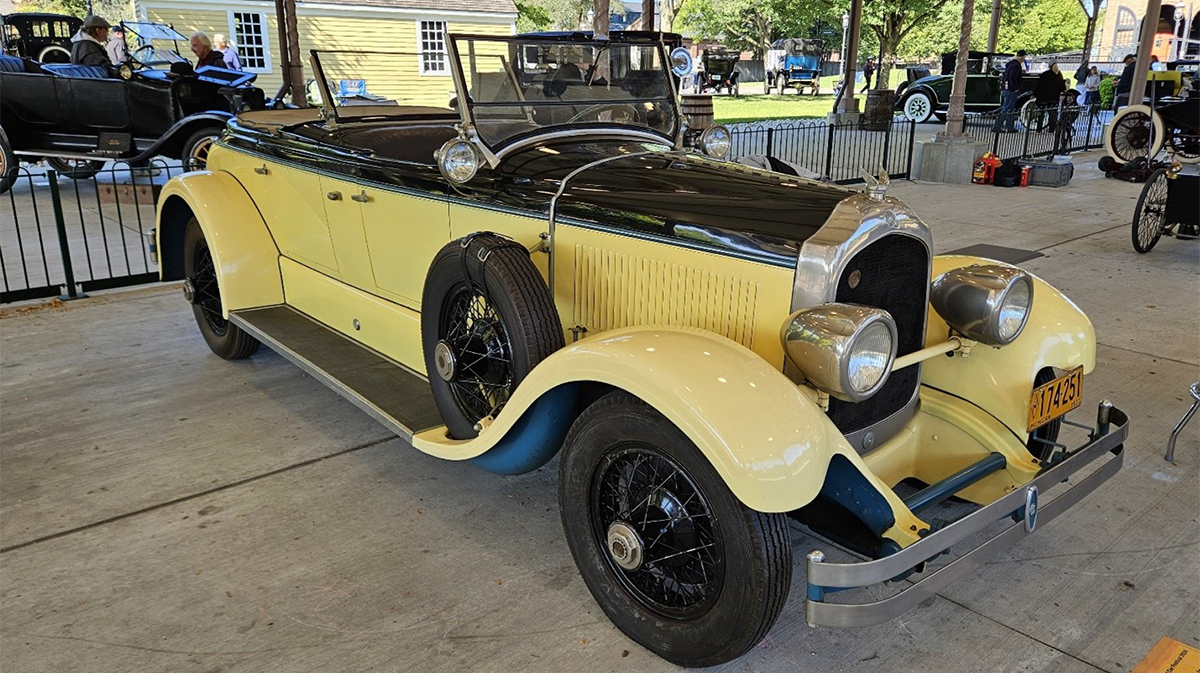
Chrysler cars, like this 1927 Imperial Sportif from The Henry Ford’s collection, were honored at this year’s Old Car Festival. / Photo by Matt Anderson
Automotive enthusiasts, history lovers, and folks just looking to have a good time descended on Greenfield Village on September 7-8, 2024, for Old Car Festival, our annual celebration of early American motoring circa 1900 to 1932. Nearly 750 cars, trucks, motorcycles, fire engines, and bicycles gathered for the show favored with sunny skies and fall-like temperatures. Attendees enjoyed good food, entertaining music and programs, and the incomparable kinetic energy of all those early gas, steam, and electric vehicles motoring through the village.
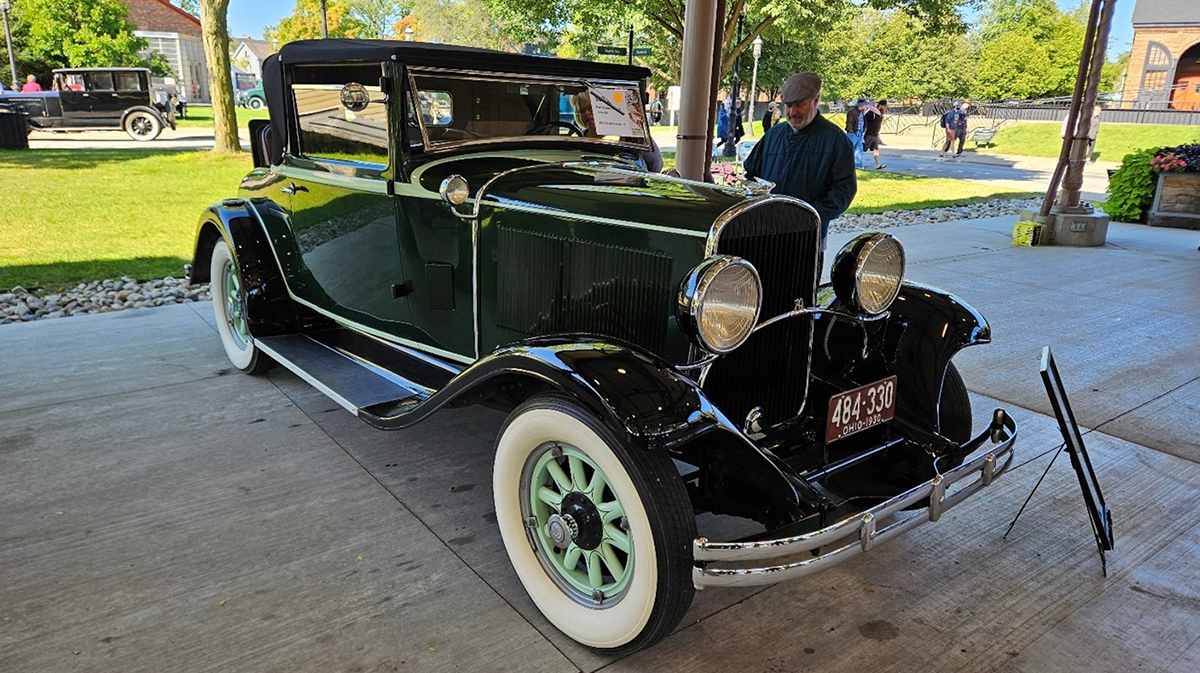
This 1930 Chrysler Series 70 was among the vehicles highlighted in Detroit Central Market. / Photo by Matt Anderson
Each year at Old Car Festival we honor a specific make or model, or we celebrate a significant anniversary. Considering that Walter P. Chrysler introduced the first Chrysler-badged cars in 1924, the Chrysler Centennial was an obvious choice for our 2024 theme. Chrysler got his start as a railroad machinist, but his abilities and industry contacts led to a job as Buick’s production head in 1911. Chrysler grew frustrated with General Motors boss William C. Durant – who enjoyed building corporations more than cars – and left in 1919. Never one to sit still, Chrysler reinvented himself as a turnaround manager, first at ailing Willys-Overland then at Maxwell. Chrysler effectively transformed Maxwell into his own Chrysler Corporation, and within five years he expanded it into a full-line automaker by purchasing Dodge Brothers and introducing mid-priced DeSoto and low-priced Plymouth.
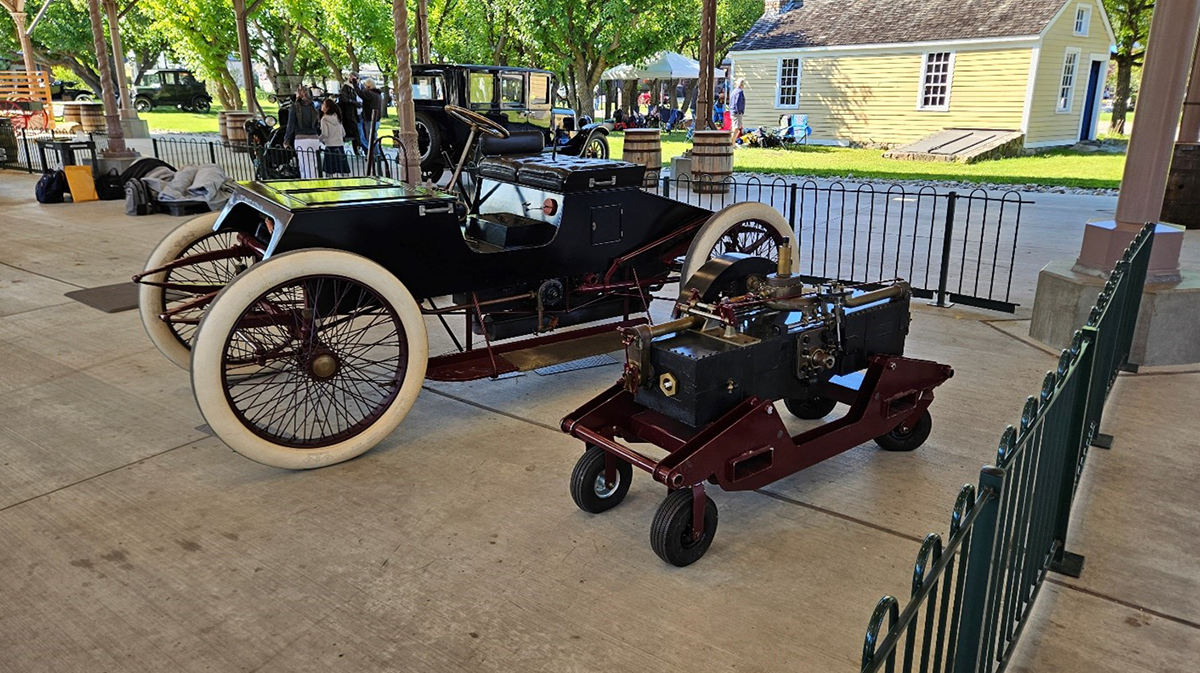
Our operating replica of Henry Ford’s 1901 “Sweepstakes” race car was in Detroit Central Market, alongside a separate copy of its 2-cylinder, 539-cubic-inch engine. / Photo by Matt Anderson
We honored Chrysler the man as much as Chrysler the company with a display in Detroit Central Market that covered all phases of his career. Several Old Car Festival participants kindly lent their own cars to the exhibit including a 1913 Buick 31, a 1920 Overland 4, a 1925 Maxwell 25-C, and various Chrysler models from 1927 to 1931 (including The Henry Ford’s own 1927 Chrysler Imperial Sportif). The special display was rounded out with a 1931 Plymouth PA and a 1932 Dodge Brothers DL.
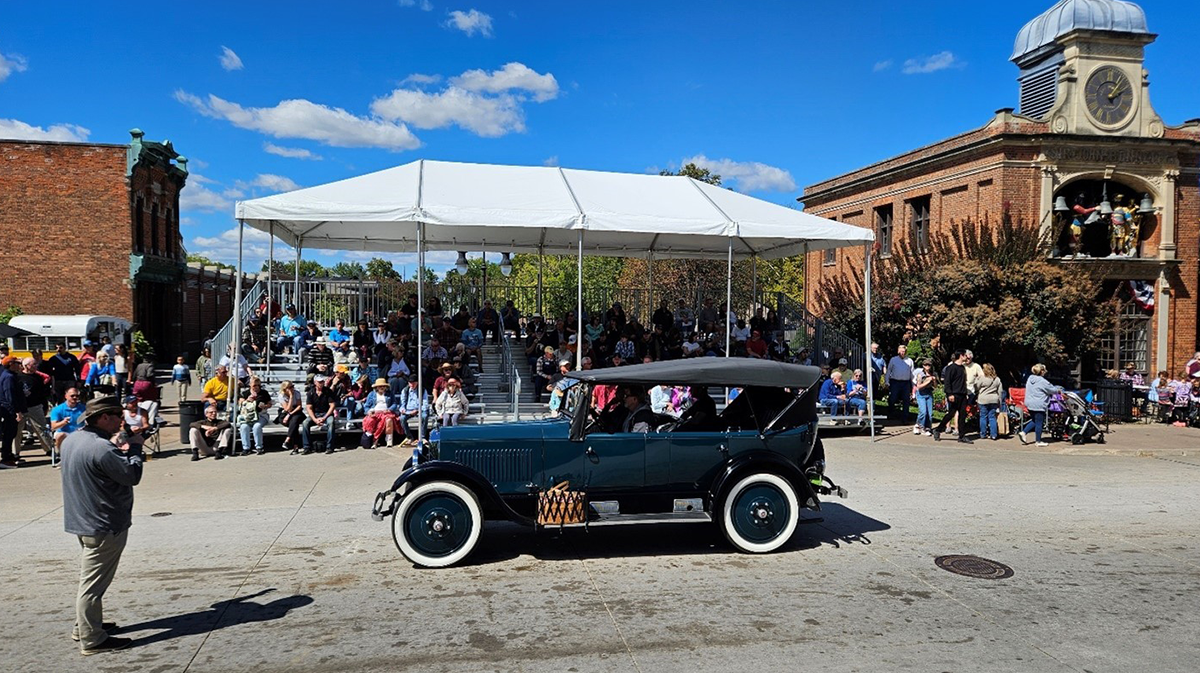
Narrated pass-in-review sessions provided a moment in the spotlight for participating cars, like this 1923 Studebaker Big Six. / Photo by Matt Anderson
For those who preferred to let the action come to them, Old Car Festival included several pass-in-review programs on Saturday and Sunday. Attendees could grab a seat in the bleachers and listen as experts like Andrew Beckman, archivist at the Studebaker National Museum, and Derek Moore, curator of collections at the Lane Motor Museum, provided commentary on passing vehicles. Folks interested in pedal-powered transportation could listen as bicycle historian Bill Smith narrated programs featuring high-wheel and safety bikes from the mid-19th century into the early 20th century.

The corner of Maple and Post hosted a Ford Model T pickup and Model A roadster alongside a 1925 Franklin sedan and a 1931 Chevrolet pickup. / Photo by Matt Anderson
Beyond pass-in-review, the weekend included two special presentations in Martha-Mary Chapel. Bob Casey, retired curator of transportation at The Henry Ford, spoke about Fred Zeder, Owen Skelton and Carl Breer, the “Three Musketeers” who designed the first of Walter Chrysler’s eponymous cars – and many more thereafter. Andy Dervan, a volunteer with our Benson Ford Research Center, presented on Ford Times, Ford Motor Company’s promotional magazine published from 1908 to 1917. Meanwhile, roadside America historian Daniel Hershberger literally set up camp near Scotch Settlement School where he presented on early auto camping throughout the weekend.

Acetylene lamps like those on this 1911 Metz lit the way during the Saturday evening gaslight tour. / Photo by Matt Anderson
Saturday evening brought its own special magic with a concert of period music by the River Raisin Ragtime Revue, and the ever-popular gaslight tour in which cars ignited their vintage acetylene lamps and paraded through the twilight. The evening festivities concluded with a Dixieland-style parade to the exit gates led by the Tartarsauce Traditional Jazz Band. Additional weekend music offerings included ragtime piano performances, blues from Rev. Robert Jones, vocal pop from the Village Trio and the Greenfield Village Quartet, and selections from the Masters of Music band and the Village Strings.
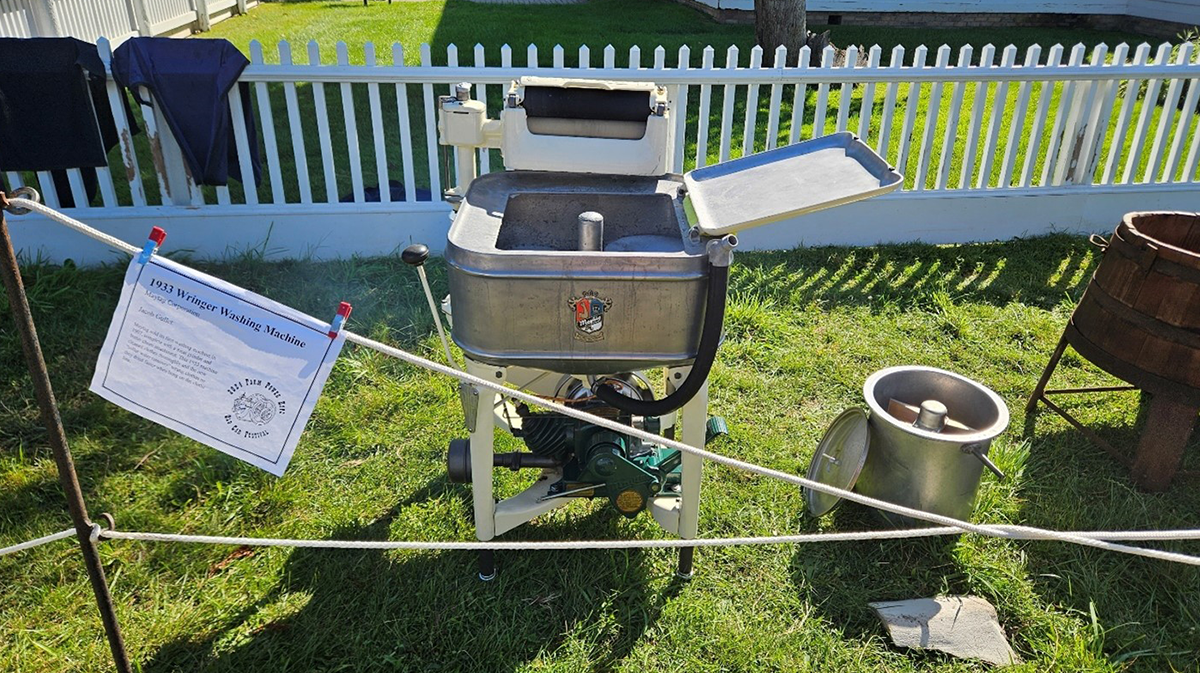
Small engines, including the one powering this early 1930s Maytag washing machine, were demonstrated at the Ford Home. / Photo by Matt Anderson
Automobile engines weren’t the only featured powerplants. Once again in 2024, the Early Engine Club put together a farm power expo at the Ford Home. Antique hit-and-miss engines, a Ford Model T powering small machines, and even a Model T converted into a tractor demonstrated the internal combustion engine’s abilities beyond motorized transportation. At the nearby Bagley Avenue Workshop, our own presenters regularly demonstrated a replica of Henry Ford's "Kitchen Sink” Engine, which powered Ford’s early ambitions toward automobile manufacturing.
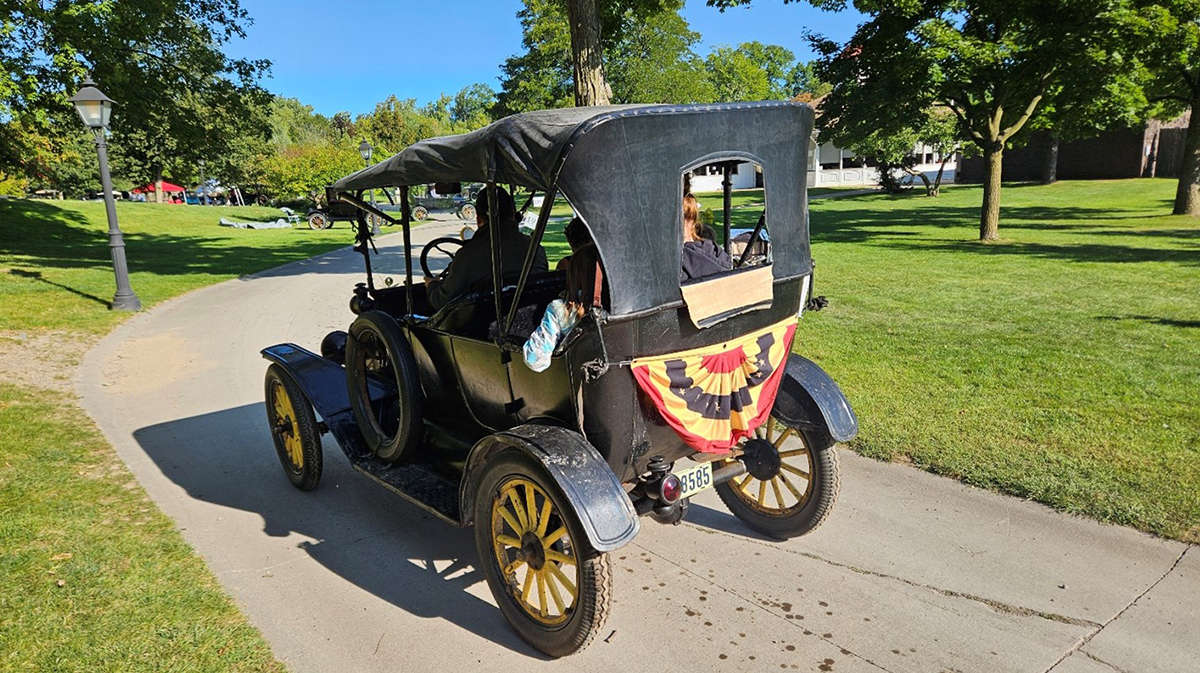
This 1916 Ford Model T, still running and still in the same family 108 years later, won a Curator’s Choice award. / Photo by Matt Anderson
As is a longstanding tradition, this year’s Old Car Festival included several cars that were judged for vehicle class awards based on authenticity, quality of restoration work, and care with which each car was maintained. First-, second-, and third-place prizes were awarded in eight classes, and one overall Grand Champion was selected for the festival. This year’s Henry Austin Clark, Jr., Grand Champion Award went to a 1932 Chevrolet Confederate Phaeton. We also presented two Curator’s Choice Awards to the best-preserved unrestored vehicles. Winners included a 1913 Oakland Model 40 Touring and a 1916 Ford Model T Touring. The complete list of our 2024 Old Car Festival award winners is available here
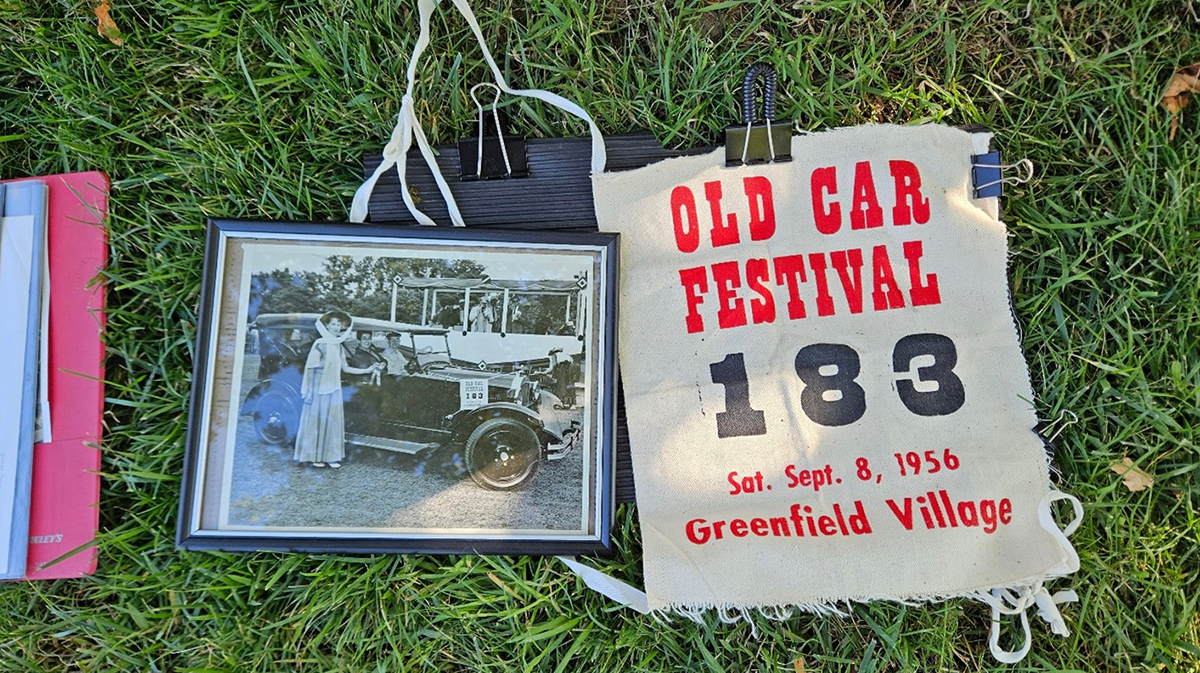
Old Car Festival is a tradition. This photo and banner are from the 1956 show, attended by a 1924 Dodge Brothers Series 116 that was here again in 2024. / Photo by Matt Anderson
We like to think that history comes alive in Greenfield Village every day, but rarely are the sights, sounds and smells of the past so fully resurrected as they are with the veteran motor vehicles of Old Car Festival. It’s an experience to savor year after year.
Matt Anderson is curator of transportation at The Henry Ford.
Early American Luxury at 2022 Old Car Festival

Banners with vintage Lincoln artwork welcomed visitors to the 2022 Old Car Festival at Greenfield Village. / Photo by RuAnne Phillips
We observed a beloved late-summer tradition September 10–11, 2022, with Old Car Festival, our annual celebration of automobiles built between the 1890s and 1932. First held in 1951, Old Car Festival is the longest-running antique automobile show in the United States. (Though we should probably put an asterisk on that, thanks to 2020, when Old Car Festival—like most events—was canceled.)
Luxury was often synonymous with a higher cylinder count. Cadillac delivered with this 1915 V-8 touring car. / Photo by Matt Anderson
Each year, we turn our spotlight on a special make, model, individual, or theme. February 2022 brought the 100th anniversary of Ford Motor Company’s acquisition of Lincoln Motor Company, so it seemed fitting to feature the broader subject of “Early American Luxury.” (We’d already celebrated Lincoln specifically at this year’s Motor Muster.) Certainly, this theme includes Lincoln, but it also encompasses names like Packard, Cadillac, LaSalle, Pierce-Arrow, and Peerless. These are the marques that defined the very term “luxury car” in the early decades of the 20th century.
Detroit Central Market housed a selection of luxury vehicles from show participants and from The Henry Ford’s own collection. / Photo by Matt Anderson
This year was our first opportunity to incorporate the Detroit Central Market building into Old Car Festival activities. We took advantage of the spacious new structure to show select upmarket American cars drawn from show participants and from The Henry Ford’s own collection. Among the museum’s cars on view were a 1915 Cadillac Type 51 touring car, representing the first mass-produced V-8 automobile, and a 1923 Lincoln Model L touring car that once belonged to Thomas Edison. We also showed our 1922 Detroit Electric coupe. The little coupe might not have seemed so impressive alongside the big touring cars, but there was a time when electric automobiles were purposely marketed to well-to-do women.
This 1915 Packard Twin Six (Packard’s term for its V-12 engine) embodies our “Early American Luxury” theme. / Photo by Matt Anderson
Several magnificent participant cars rounded out our Central Market display. From Packard, we had a 1915 Twin Six touring car and a 1927 Series 626 sedan. From Franklin, we had a 1931 Series 151 sedan. Auburn—part of E.L. Cord’s Auburn-Cord-Duesenberg empire—was represented by a pair of beautiful 1929 models, including a cabriolet and one of the company’s beloved boat-tail speedsters. Our special exhibit wasn’t limited to exclusive marques. Luxury cars for customers of (relatively) more modest means were represented by a 1928 Studebaker President sedan and a 1930 LaSalle coupe.
Model T cars, wagons and trucks were everywhere at Old Car Festival, including this 1924 depot hack parked near Sarah Jordan Boarding House. / Photo by RuAnne Phillips
We had more than 730 vehicles registered for this year’s show. Automobiles, station wagons, trucks, bicycles, and even a few military vehicles were spread throughout Greenfield Village over the weekend. Visitors could enjoy the sights and sounds of a 1910s ragtime street fair along Washington Boulevard. They could attend a 1920s-era community garden party near Ackley Covered Bridge. They could watch the Canadian Model T assembly team put together a Ford automobile in mere minutes. Or they could hear about wartime struggles on the Western Front outside Cotswold Cottage. At the Ford Home, near the village entrance, Old Car Festival visitors could take in an exhibition of tractors and internal-combustion engines that took some of the backbreaking labor out of early-20th-century farming. For festival participants in a matrimonial mood, our friends at Hagerty arranged a Drive-Thru Vow Renewals experience. Registered show-car owners could drive their antique vehicles past the makeshift altar in front of Edison Illuminating Company’s Station A and “re-light” their nuptials.
Martha-Mary Chapel provided an inspiring backdrop for cars on the Village Green. It also housed a series of special programs throughout the weekend. / Photo by RuAnne Phillips
Speaking of altars, Martha-Mary Chapel hosted several programs and presentations during Old Car Festival. Tom Cotter, author and host of the popular web series Barn Find Hunter, presented twice during the weekend. On Saturday, he went behind the scenes of his car-seeking show with “A Barn-Finding Life.” On Sunday, Cotter recalled the 3,000-mile journey chronicled in his book Ford Model T Coast to Coast. On both days, longtime festival participant Daniel Hershberger discussed early auto touring and roadside camping. Hershberger dedicated his talks to the memory of Randy Mason, a former curator of transportation at The Henry Ford who passed away earlier this year. Also on both days, historian Joseph Boggs looked at the fascinating relationship between automobiles and 1920s Prohibition. Cars factored into both sides of the equation—used by rumrunners and law enforcement officers alike.
Of special interest were two panel discussions on early American luxury cars, held on Saturday and Sunday. Through the generous support of the Margaret Dunning Foundation, we brought together three experts in the field: Bob Casey, retired curator of transportation at The Henry Ford; David Schultz, president of the Lincoln Owners Club; and Matt Short, former curator at the Auburn-Cord-Duesenberg Automobile Museum and former director of America’s Packard Museum. Our panelists discussed the innovators, manufacturers, and automobiles that defined luxury motoring into the 1930s. Their Sunday session was livestreamed and can be viewed here on The Henry Ford’s Facebook page.
Select participating vehicles at Old Car Festival were judged for various class awards. From those winners, one grand champion was selected each day. / Photo by RuAnne Phillips
Visitors may not be aware of a special distinction (apart from chronology) that separates Old Car Festival from our Motor Muster show. Participants at Old Car Festival can choose to have their vehicles judged by a team of vintage-automobile experts. The judges determine Vehicle Class Awards based on authenticity, quality of the restoration work, and care with which each car is maintained. First-, second-, and third-place prizes are awarded in 11 different classes. One overall Grand Champion is selected on each day of the festival. Additionally, two Curator’s Choice Awards are presented to unrestored vehicles, and guests and participants are invited to vote for their favorites in the People’s Choice Awards. The full list of our 2022 award winners may be viewed here.
Old Car Festival includes trucks, too. Commercial vehicles line Christie Street during the event. / Photo by RuAnne Phillips
Great crowds, good weather, and impressive vehicles made for a perfect show in 2022. While it’s always hard to say goodbye to summer, Old Car Festival is certainly a fine way to do it. We look forward to next year’s event already.
Matt Anderson is Curator of Transportation at The Henry Ford.
Michigan, Dearborn, 21st century, 2020s, Old Car Festival, luxury cars, Greenfield Village, events, cars, car shows, by Matt Anderson
Celebrating Women at the Wheel at the 2021 Old Car Festival

“Women at the Wheel,” like the duster-clad driver at the controls of this 1907 Cadillac Model K, were spotlighted at this year’s Old Car Festival.
After a longer-than-usual pause, Old Car Festival returned to Greenfield Village on September 11–12, 2021. Our celebration of early American motoring included more than 700 registered cars, trucks, motorcycles, and bicycles dating from the 1890s to 1932.
Each year we shine our spotlight on a particular make, model, or theme. For 2021, we celebrated “women at the wheel” in commemoration of the 101st anniversary of the ratification of the 19th Amendment, which gave American women the right to vote. The automobile played a significant part in the fight for women’s suffrage. Cars expanded the range and reach of suffragists, allowing them to spread their message to smaller villages and hamlets located away from railroads. The automobile also provided a prominent mobile platform on which to hang signs and banners, and a traveling stage from which to make speeches and calls to action.
Ford Motor Company advertisements promoted the Model T as a source of freedom for American women.
From the start, automakers appealed specifically to women with targeted advertisements and booklets. Makers of early electric cars made a special point of advertising to well-to-do female buyers. Unlike early gasoline cars, electrics were clean, quiet, and required no crank starting or gear shifting. But many women weren’t bothered in the least by the gasoline car’s disadvantages. Alice Huyler Ramsey drove a gas-powered Maxwell across the United States in 1909, becoming the first woman to make the coast-to-coast road trip.
This 1912 Baker Electric was used by five First Ladies of the United States. / THF67884
We celebrated women at the wheel with a very special 1912 Baker Electric Victoria. It was purchased for use at the White House by President William Howard Taft and driven by First Lady Helen Taft. When the Tafts left, the Baker stayed behind and was used by four subsequent First Ladies: Ellen Wilson, Edith Wilson, Florence Harding, and Grace Coolidge. The Baker was retired in 1928 and, shortly thereafter, made its way to The Henry Ford. Guests who made their way to The Lodge at Christie & Main saw the Baker on display alongside our 1922 Detroit Electric, and our replicas of Henry Ford’s 1896 Quadricycle and his 1901 “Sweepstakes” race car.
Dancing under the streetlights, to the music of the River Raisin Ragtime Review, capped off Saturday evening.
Show participants and guests enjoyed a variety of activities built around the three decades represented by Old Car Festival’s vehicles. From the 1900s, we had a group of aged Civil War veterans enjoying a Grand Army of the Republic picnic. From the 1910s, we had a Ragtime Street Fair with music and dancing up and down Washington Boulevard. We had a few American doughboys stationed near Cotswold Cottage as well, lest we forget the Great War and its impact on daily life and industrial production. We commemorated the Roaring ’20s with a community garden party near the Bandstand, and—in keeping with our theme—with a presentation by historian Joseph Boggs on the “New Woman,” who challenged traditional gender norms during that exciting decade.
Expert narrators commented on cars, like this rare 1907 Richmond Merry Widow built by Wayne Works, during Pass-in-Review.
Naturally, those who came for the cars weren’t disappointed. We had everything from Auburns to Willys-Knights parked on every patch of open grass in Greenfield Village. As usual, our team of expert historians was on hand to narrate Pass-in-Review parades that included everything from 19th-century bicycles (brought by the always entertaining Michigan Wheelmen) to commercial trucks, wreckers and depot hacks. (If you weren’t able to see the Pass-in-Review in person, or would like to catch something again, you can watch the early vehicles, commercial vehicles, and bicycles parades on our Facebook page.) We finished off on Saturday evening with the gaslight tour. Anyone who’s experienced it will agree that watching those early autos parade through the village with their flickering gas and early electric lamps is a magical sight.
Old Car Festival attracts a variety of motive power, but steam cars like this 1909 White Model O are always a hit.
There’s just something special about Old Car Festival. Several participants have told me that the show is the highlight of the year for them—bigger than birthdays and holidays. I think we all found a little extra joy this time out, resuming a beloved tradition that’s been a part of Greenfield Village for 70 years. We’ll look forward to seeing all our friends again in 2022.
Matt Anderson is Curator of Transportation at The Henry Ford.
Michigan, Dearborn, 21st century, 2020s, women's history, voting, Old Car Festival, Greenfield Village, events, cars, car shows, by Matt Anderson
Remembering Mose Nowland (1934-2021)

Mose Nowland, with wife Marcia and daughter Suzanne, at The Henry Ford in June 2021.
The Henry Ford lost a dear friend and a treasured colleague on August 13, 2021, with the passing of Mose Nowland. When he joined our Conservation Department as a volunteer in 2012, Mose had just concluded a magnificent 57-year career with Ford Motor Company—most of it in the company’s racing program—and he was eager for something to keep himself occupied in retirement. We soon discovered that “retire” was just about the only thing that Mose didn’t know how to do.
To fans of Ford Performance, Mose was a legendary figure. He joined the Blue Oval in 1955 and, after a brief pause for military service, he spent most of the next six decades building racing engines. Mose led work on the double overhead cam V-8 that powered Jim Clark to his Indianapolis 500 win with the 1965 Lotus-Ford. Mose was on the team behind the big 427 V-8 that gave Ford its historic wins over Ferrari at Le Mans—first with the GT40 Mark II in 1966 and then again with the Mark IV in 1967. And Mose was there in the 1980s when Ford returned to NASCAR and earned checkered flags and championships with top drivers like Davey Allison and Bill Elliott.
Mose with one of his creations during Ford’s Total Performance heyday.
Following his retirement, Mose transitioned gracefully into the role of elder statesman, becoming one of the last remaining participants from Ford’s glory years in the “Total Performance” 1960s. Museums and private collectors sought him out with questions on engines and cars from that era, and he was always happy to share advice and insight. Mose’s expertise was exceeded only by his modesty. He never claimed any personal credit for Ford’s racing triumphs—he was just proud to have been part of a team that made motorsport history. Mose was able to see that history reach a wider audience with the success of the recent movie Ford v Ferrari.
Michigan, Dearborn, The Henry Ford staff, 21st century, 20th century, racing, race cars, philanthropy, Old Car Festival, Model Ts, Mark IV, making, in memoriam, Henry Ford Museum, Greenfield Village, Ford workers, Ford Motor Company, engines, engineering, collections care, cars, by Matt Anderson, #Behind The Scenes @ The Henry Ford
A Tribute to Old Car Festival

This year would have marked the 70th anniversary of Old Car Festival, the longest running antique car show in America. While due to the COVID-19 pandemic, we currently can’t be immersed in the moving stories of the early automotive era, we didn’t want to miss the opportunity to celebrate our longest running and one of our most loved events in Greenfield Village.
Old Car Festival is more than just a car show. It’s an experience. It’s the detail that goes into the costumes and settings of the vignettes created by our staff that depict the turn of the century to the Great Depression. It’s the blues, jazz and Ragtime that you can hear throughout the streets and the dancing to go with it. It’s the delicious food offerings from our culinary team. It’s the sight and smell of more than 800 vehicles taking to the streets and taking over nearly every corner of the village. All of it together transports our participants, members, guests and staff back to a time when these vehicles created their own roads. 
All of it wouldn’t be possible of course, without our wonderful participants who come year after year to take their cherished treasures out for a spin (or just for show in some cases), participate in games of skill out on Walnut Grove and share their favorite stories with those who pass by. 
In addition to the 70th anniversary of Old Car Festival, this year’s event would have also celebrated the centennial of the 19th Amendment. Automobiles arrived just as women were making new inroads in the workplace and in civic engagement. It’s not too much to say that the car’s freedom of mobility made an important contribution to this social change. On September 10, our curator of transportation Matt Anderson participated in a special THF Conversations for our members on “Women behind the Wheel,” taking a look at how early American carmakers marketed to women and the role the car played on the road to suffrage. (The link to this video will be available here soon, or read about the same topic here.)
We look forward to making more Old Car Festival memories soon. Until then, stay safe and have a great weekend--and if you want, explore round-ups from previous Old Car Festivals on our blog here.
Melissa Foster is Senior Manager of Public Relations at The Henry Ford.
Michigan, Dearborn, 21st century, 2020s, Old Car Festival, Greenfield Village, events, COVID 19 impact, cars, car shows, by Melissa Foster
Celebrating Early Sports Cars at Old Car Festival 2019

This 1930 Hupmobile Model S was one of nearly 800 vehicles that filled Greenfield Village for this year’s Old Car Festival.
Another summer car show season is in the books as we wrap up our 69th annual Old Car Festival in Greenfield Village. We enjoyed practically perfect weather, enthusiastic crowds, and a field of nearly 800 vintage automobiles, trucks, motorcycles, and bicycles. You couldn’t have asked for a better weekend – or a better way to spend it.
This 1925 Ford Model TT truck fit perfectly with the Depression-era Mattox Family Home. Greenfield Village provides an incomparable setting for Old Car Festival.
Our spotlight for 2019 shined on early sports cars, whether genuine performers like the Stutz Bearcat, or mere sporty-looking cars like Ford’s Model T Torpedo Runabout. We usually associate sports cars with postwar imported MGs or all-American Corvettes, but enthusiast motoring is an old idea. For as long as there have been cars, there have been builders and buyers dedicated to the simple idea that driving should be fun.
The Henry Ford’s 1923 Stutz Bearcat. Many consider the Bearcat to be America’s first true sports car.
In keeping with the theme, we featured three sporty cars in our special exhibit tent across from Town Hall. From The Henry Ford’s own collection, we pulled our 1923 Stutz Bearcat. If there’s one name synonymous with early sporting automobiles, it’s “Bearcat.” Indianapolis-based Stutz introduced the model in 1912. The first-generation Bearcat featured only the barest bodywork and a trademark “monocle” windshield. Our later model was a bit more refined but, with 109 horses under the hood, it had no problems pushing the speedometer needle to the century mark. And, with its $3500 price tag, it had no problems pushing your bankbook into the red, either.
The sporty, affordable 1926 Chevrolet – for when the heart says, “speed up” but the wallet says, “slow down.”
Our good friends at General Motors once again shared a treasure from the company’s collection. This time it was a beautiful 1926 Chevrolet Superior Series V. The car boasted custom bodywork from the Mercury Body Company of Louisville, Kentucky. The speedster body and disc wheels gave a sporty look to a car targeted at budget-minded buyers. The Chevy sold for $510 – about one-seventh the cost of that Stutz!
This newly-restored 1927 Packard ambulance served the city of Detroit for nearly 30 years.
Every car at Old Car Festival has its own story, but some of them are particularly special. You could certainly say that about the 1927 Packard ambulance bought to us by owner Brantley Vitek of Virginia. He purchased the vehicle, in rather rough condition, at the Hershey swap meet in 1974. Dr. Vitek planned to restore it but, as is sometimes the case for car collectors, life got in the way. He wasn’t able to start the project until 2016, but it was well worth the wait. The finished ambulance is gorgeous – and not without southeast Michigan ties. The Packard served all its working life with the Detroit Fire Department. Old Car Festival wasn’t just a debut for the completed project, it was a homecoming as well.
The corn boil was just one of the dietary delights offered at this year’s show.
Veteran Old Car Festival attendees know that the show mixes a little gastronomy with its gasoline. Each year brings historically-inspired foods to the special “Market District” set up along the south end of Greenfield Village’s Washington Boulevard. Offerings for 2019 included turkey legs, sliced pastrami sandwiches, baked beans and cornbread (served in a tin cup), and peach cobbler. Longstanding favorites like kettle corn, hobo bread, and frozen custard were on hand too.
Prize winners received glass medallions handcrafted in the Greenfield Village Glass Shop.
As it does every year, Old Car Festival wrapped up with the Sunday afternoon awards ceremony. Show participants are invited to submit their vehicles for judging. Expert judges award prizes based on authenticity, quality of restoration, and the care with which each vehicle is maintained. First, second, and third-place prizes are awarded in eight classes, and one Grand Champion is selected for each of the show’s two days. Additionally, two Curator’s Choice awards are given to significant unrestored vehicles.
The Canadian Model T Assembly Team entertained by putting together this vintage Ford in mere minutes.
Year after year, Old Car Festival provides sights, sounds, and tastes to delight the senses. It’s no wonder the show has been going strong for 69 years. We’ll see you for show number 70 in 2020!
Matt Anderson is Curator of Transportation at The Henry Ford.
Michigan, Dearborn, 21st century, 2010s, Old Car Festival, Greenfield Village, events, cars, car shows, by Matt Anderson
Trucks Take the Spotlight at the 2018 Old Car Festival

Factory-built trucks, like this 1931 Ford Model A pickup, were the highlight at this year’s Old Car Festival in Greenfield Village.
Another summer car show season has come and gone, but it was capped off in spectacular fashion with the 68th annual Old Car Festival. More than 750 bicycles, automobiles and trucks filled Greenfield Village with the sights and sounds of motoring circa 1900-1932.
This year’s theme commemorated a century of factory-built trucks. Chevrolet introduced its first half-ton and one-ton trucks in 1918. Ford technically built its first Model TT trucks in 1917, but TT production that first year was so small that it seems fair to celebrate the Ford truck centennial in 2018, too. Regular Old Car Festival attendees know that – despite the show’s name – trucks have long been a part of the event, but this year the spotlight was theirs. In addition to the many participant trucks, our friends at the GM Heritage Center kindly provided a 1926 Chevrolet Superior Series X pickup for display, while we pulled out a 1925 Ford Model TT stake truck from The Henry Ford’s collection. A group of eight Sears high wheelers heads through Pass-in-Review – with the non-runner towed by a 1921 Fordson Model F tractor.
A group of eight Sears high wheelers heads through Pass-in-Review – with the non-runner towed by a 1921 Fordson Model F tractor.
Old Car Festival always brings together a mix of the rare and the common, the strange and the standard, and this year was no exception. Among the highlights was a group of eight Sears high wheelers. From 1909 to 1912, aspiring motorists could order complete cars (along with just about everything else) from the Sears catalog. Priced around $400, the cars were solid if not spectacular, but their arrival was something of a cultural milestone. If *Sears* was selling them, then surely these horseless carriages were here to stay! Even 130 years after “safety” bicycles supplanted them, high-wheel “ordinary” bikes continue to fascinate.
Even 130 years after “safety” bicycles supplanted them, high-wheel “ordinary” bikes continue to fascinate.
Not every vehicle at Old Car Festival had a motor. Once again members of the Michigan Wheelmen brought a variety of period bicycles, from a replica of a circa 1817 draisine (the bicycle’s earliest, peddle-less ancestor), to intimidating high wheelers of the 1870s, to more conventional “safety” bikes of the sort Wilbur and Orville Wright sold in the 1890s. Throughout the weekend, the Wheelmen wowed the crowds with their displays of skill – from bicycle games, to stunts, to simply managing to climb aboard something with a front wheel 58 inches high. Visitors enjoyed an additional musical treat this year as organist Dave Wagner performed hit songs of the early automobile era on the newly-restored pipe organ in the Menlo Park Laboratory.
Visitors enjoyed an additional musical treat this year as organist Dave Wagner performed hit songs of the early automobile era on the newly-restored pipe organ in the Menlo Park Laboratory.
Our decade vignettes, so popular last year, returned for 2018. For the Aughts, we had a group of Civil War veterans enjoying a G.A.R. reunion picnic (with a period-appropriate blend of horse-drawn and motorized transportation). For the 1910s, we had a Ragtime street fair complete with fast-fingered pianists, vintage games, and tasty foods along Washington Boulevard. At the other end of the village near Cotswold Cottage – “over there,” if you will – a group of World War I reenactors commemorated the centennial of the Armistice. The Roaring ’20s were recalled with a concert and dancing at the bandstand near the Ackley Covered Bridge. And the somber early years of the Great Depression came to life through the blues guitar of the Rev. Robert Jones. Another rare sight: five Model K Fords attended the show. Today the big six-cylinder K is unfairly dismissed as a failure. In truth, it sold well – and quite profitably – between 1906 and 1908.
Another rare sight: five Model K Fords attended the show. Today the big six-cylinder K is unfairly dismissed as a failure. In truth, it sold well – and quite profitably – between 1906 and 1908.
Whether it was your first visit or your 21st, Old Car Festival surely offered something to bring a smile to your face or a tap to your toe. It’s a car show like no other, and one we’ve been proud to present year after year.
Matt Anderson is Curator of Transportation at The Henry Ford.
Michigan, Dearborn, 21st century, 2010s, Old Car Festival, Greenfield Village, events, cars, car shows, by Matt Anderson
An Old Car Festival for the Books: 2017

The Canadian Model T Assembly Team wowed Old Car Festival crowds by putting together a working chassis in less than 10 minutes.
Our 67th annual Old Car Festival is in the books – and it was one for the books this year. Postcard-perfect weather, a host of new activities and hundreds of vintage automobiles from motoring’s first decades made this one of the most exciting Greenfield Village car shows in recent memory. This yellow 1921 Lincoln, from the Cleveland History Center, is believed to be the earliest surviving Lincoln motor car.
This yellow 1921 Lincoln, from the Cleveland History Center, is believed to be the earliest surviving Lincoln motor car.
Lincoln took center stage as our featured marque. It was 100 years ago that Henry Leland left Cadillac to form what would become his second automobile company, named for the first president for whom he voted. We had a number of important Lincolns on hand. From The Henry Ford’s own collection was the circa 1917 Liberty V-12 aircraft engine (Lincoln’s first product) and the 1929 Dietrich-bodied convertible. Our friends at the Cleveland History Center’s Crawford Auto-Aviation Collection brought something very special: a 1921 Model 101 believed to be the oldest surviving Lincoln automobile. The earliest cars, like this red 1903 Ford Model A runabout, line up for their turn at Pass-in-Review.
The earliest cars, like this red 1903 Ford Model A runabout, line up for their turn at Pass-in-Review.
Automotive enthusiasts had their pick of activities. There were the cars, of course, spread chronologically throughout the village. There were the Pass-in-Review parades, in which our expert narrators commented on participating vehicles as they drove past the Main Street grandstand. There were the car games, and continuing demonstrations by the Canadian Model T Assembly Team, in Walnut Grove. There were bicycle games near (appropriately enough) Wright Cycle Company. And there were presentations on various auto-related topics in Martha Mary Chapel and the Village Pavilion. Old Car Festival welcomed a few genuinely rare cars in addition to the wonderfully ubiquitous (Ford, Chevrolet, Dodge Brothers) and downright obscure (Crow, Liberty, Norwalk). Rarities this year included a 1913 Bugatti Type 22 race car (said to be the oldest Bugatti in North America) and a 1914 American Underslung touring car (purportedly the last vehicle produced by the company). Staff presenters and show participants alike dressed in period clothing, adding to the show’s atmosphere.
Staff presenters and show participants alike dressed in period clothing, adding to the show’s atmosphere.
But this year, the cars were only the beginning. Greenfield Village hosted activities and historical “vignettes” keyed to each decade represented in the show. Aging Civil War veterans reminisced about Shiloh and Gettysburg at the Grand Army of the Republic encampment. Farther into the village, doughboys and nurses commemorated the centennial of America’s entry into the Great War. Sheiks and Shebas danced the Charleston at the bandstand near Ackley Covered Bridge. Southern blues resonated through the Mattox Home, evocative of the Great Depression’s bleakest years. Perhaps the most popular vignette, though, was the 1910s Ragtime Street Fair occupying the southern end of Washington Boulevard. Great food, games and dancing filled the street, all set to music provided by some of the most talented piano syncopators this side of Scott Joplin. It’s magical when the sun sets and the headlamps turn on, like those on this 1925 Buick Master 6 Touring.
It’s magical when the sun sets and the headlamps turn on, like those on this 1925 Buick Master 6 Touring.
Longtime show participants and visitors will tell you that the highlight comes on Saturday evening. As the sun sets in the late-summer sky, drivers switch on (or fire up) their acetylene, kerosene and electric headlamps for the Gaslight Tour through Greenfield Village. Watching the parade, it’s hard to tell who enjoys it more – the drivers and passengers, or the visitors lined up along the route. This year’s tour was capped by a fireworks display at the end of the night.
It was a special weekend with beautiful automobiles, wonderful entertainment and – most of all – fellowship and fun for those of us who love old cars. Congratulations to the 2017 Old Car Festival Award Winners.
Matt Anderson is Curator of Transportation at The Henry Ford.
Michigan, Dearborn, 21st century, 2010s, Old Car Festival, Greenfield Village, events, cars, car shows, by Matt Anderson
Looking Back on Old Car Festival 2015

Another car show season drew to a close with our Old Car Festival on September 12-13. It’s always disheartening for car fans – and warm weather fans – to see summer go, but the festival makes for a great climax. This year we had more than 900 cars, bicycles and commercial vehicles registered for the event. Every one of them dated from the 1890s to 1932, a time of innovation, evolution and variety. Visitors to Greenfield Village saw everything from the ubiquitous Ford Model T to the downright obscure Havers (only a handful of these cars, built in Port Huron, Michigan, from 1911-1914, are thought to survive). Continue Reading
Michigan, Dearborn, 21st century, 2010s, Old Car Festival, Greenfield Village, events, cars, car shows, by Matt Anderson
Remembering George DeAngelis

George DeAngelis, a long-time Ford Motor Company employee and devoted student of Henry Ford and his automobiles, passed away on December 14, 2014. Mr. DeAngelis is remembered for his published works on the Ford Model A and the Ford V-8, as well as Henry Ford’s early 999 and Arrow race cars. Here at The Henry Ford, though, we especially remember him for a pair of three-dimensional contributions: his incredible 1963 and 1991 replicas of Henry Ford’s first car, the 1896 Quadricycle.
Regular visitors to Henry Ford Museum know that the Quadricycle – the original car built by Henry Ford himself – occupies a prominent place in our Driving America exhibit. While the original car was used frequently during Henry Ford’s life – indeed, he posed with it less than a year before he died – it was retired to Henry Ford Museum by 1963, the centennial of Henry Ford’s birth. DeAngelis set out to build a working replica for the celebration. DeAngelis had the perfect background for the task. He possessed the skills of a tool and die maker, but with the careful eye of an artist. He had a genuine love for antique automobiles, to boot.
There were no blueprints of the Quadricycle, so DeAngelis gathered every written description and photograph he could find. Of course, he also had the original Quadricycle as a pattern. The historic car sat in an enclosed display case, so DeAngelis estimated his initial measurements through the glass. Amazingly, when the original Quadricycle was removed for confirmation, DeAngelis found he had made only one error – and of just 5/8 of an inch!
What DeAngelis thought would be a one-winter project turned into three years of nights and weekends. He was able to source some of his parts from lawn mower catalogs, and some from antique shops, but most he made himself. While the replica stayed remarkably true to the original, DeAngelis made a few concessions to safety and reliability. Most notably, he gave his replica a brake – something Henry’s Quadricycle never had. The work was finished by June 4, 1963, when DeAngelis drove his replica along the same route Henry Ford took during the original Quadricycle’s first drive on June 4, 1896.

When the festivities ended, The Henry Ford purchased the replica from George DeAngelis. Over the years, the 1963 copy became a staple of our annual Old Car Festival, thrilling visitors each year as museum staff drove it through Greenfield Village. In a neat coda to the story, we commissioned DeAngelis to build a second Quadricycle replica nearly 30 years later. DeAngelis’s 1991 replica now sits in the reconstruction of Henry Ford’s Bagley Avenue shed in Greenfield Village.
Matt Anderson is Curator of Transportation at The Henry Ford.
Michigan, 21st century, 20th century, quadricycle, Old Car Festival, making, in memoriam, Henry Ford Museum, Henry Ford, Greenfield Village, Ford workers, Ford Motor Company, Driving America, cars, by Matt Anderson

